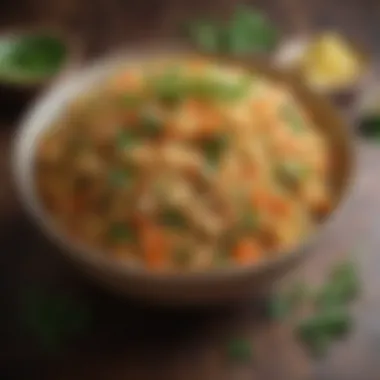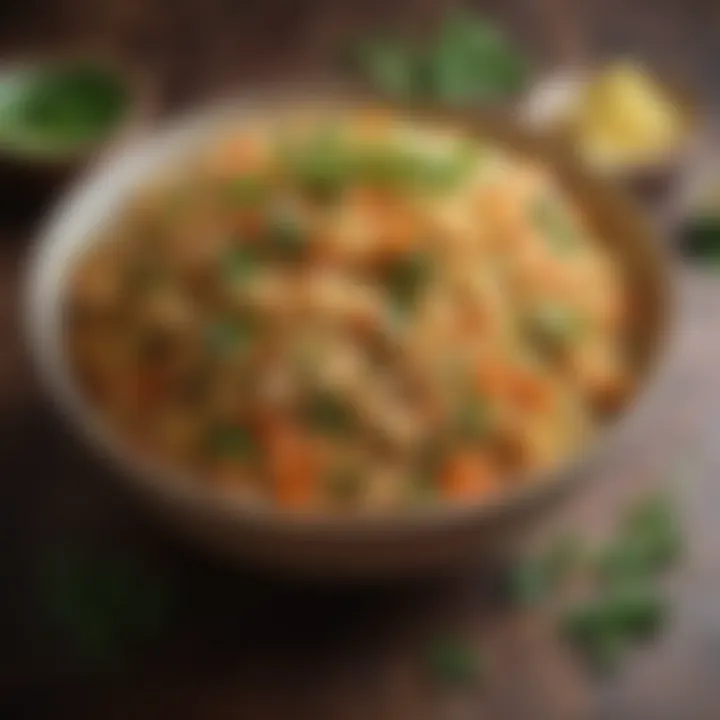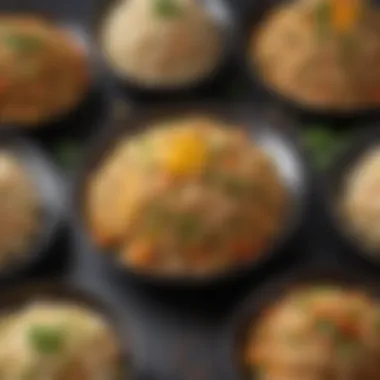Mastering the Techniques of Refried Rice


Intro
When it comes to the realm of comfort food, refried rice often takes a front seat. It's not just a side dish; it's a culinary canvas where flavors and techniques meet. Whether you're at a family gathering or enjoying a quiet dinner at home, refried rice has a certain way of making a meal feel complete. This article aims to peel back the layers of this deceptively simple dish, revealing its nuanced techniques, special ingredients, and traditions passed down through generations.
Recipe Overview
Recipe Name
Deliciously Refried Rice
Description of the Dish
Refried rice is a delightful medley of ingredients transformed into a satisfying dish. Traditionally made with leftover rice, it creates an opportunity to breathe new life into what might otherwise be an afterthought on the dinner table. With the right ingredients and techniques, you can elevate it into a star player of the meal, offering taste and texture that sings.
Commonly found in Mexican cuisine, though enjoyed worldwide, refried rice can capture the essence of home-cooked goodness. They say the secret is in the technique, from the way you season it to how you stir it, ensuring that each grain is coated just right.
"Refried rice isn’t just about reheating. It’s about reviving flavors and crafting a creation that feels lovingly made."
Ingredients
To kickstart your journey into crafting the perfect refried rice, let’s first take a gander at what you’ll need:
- 4 cups cooked rice (preferably day-old for best results)
- 2 tablespoons cooking oil (olive, canola, or coconut work well)
- 1 small onion, finely chopped
- 3 cloves of garlic, minced
- 1 cup corn (frozen or canned works fine)
- ½ cup bell pepper, diced (red or green, or both for color)
- 1 teaspoon ground cumin
- Salt and pepper to taste
- Fresh cilantro (for garnish)
While this list serves as a solid foundation, it’s worth noting some special considerations. For those who might be looking for substitutions or regional variants:
- Rice: While long-grain white rice is standard, switching to jasmine or basmati can impart a unique aroma and flavor.
- Vegetables: Zucchini, peas, or even diced tomatoes can be tossed in depending on what’s on hand or your cravings.
- Spices: Feel free to switch out cumin for smoked paprika or add chili powder for a little kick.
Let’s get cooking!
Understanding Refried Rice
Refried rice, a staple dish in many cuisines, serves as a culinary canvas that adapts to various flavors and ingredients. It's not just about reheating leftovers; it’s about elevating simple rice into something comforting and satisfying. Understanding the significance of refried rice involves appreciating its cultural roots, the techniques that enhance its flavor, and recognizing its role in meal preparation. This section will delve into the definition, origin, and cultural variations that shape this versatile dish.
Definition and Origin
Refried rice typically refers to rice that has been cooked and then pan-fried, often alongside a medley of other ingredients. Unlike the name might suggest, it is not literally fried twice; the term reflects its cooking process, where the rice is sautéed to produce a distinct texture and flavor.
This dish has origins that trace back to various cultures. The term "refried" can be misleading, as the concept of taking cooked rice and enhancing its flavor through frying isn’t unique to any single tradition. Many cultures have their version, such as:
- Mexican: Often associated with Mexican cuisine, refried beans are combined with rice, creating a flavorful blend often served with enchiladas or tacos.
- Chinese: In Chinese cuisine, fried rice is made, which involves tossing day-old rice with vegetables, proteins, and soy sauce.
- Indian: In India, similar concepts appear with rice dishes like "biryani" where rice is cooked with spices, although not specifically "refried."
While the specific preparations might differ, the essence of transforming humble rice into a comforting dish remains a common thread.
Variations Across Cultures
The variations of refried rice across cultures reflect the local ingredients and culinary practices. Each region adapts the dish to suit its flavors and traditions. Here are some notable examples:
- Mexican Refried Rice: Known for its bold flavors, often infused with spices like cumin and topped with fresh cilantro. It frequently accompanies beans or grilled meats.
- Chinese Yangzhou Fried Rice: This iconic dish is colorful with a medley of vegetables, eggs, and sometimes shrimp or chicken, showcasing the importance of fresh ingredients in Chinese cooking.
- Korean Bokkeumbap: Korean fried rice can feature a variety of ingredients, including kimchi, which introduces a tangy flavor profile that’s distinctly Korean.
- Middle Eastern Considerations: Various Middle Eastern rice dishes may incorporate spices like saffron and can include a variety of veggies and meats, enriching the flavors with aromatic elements.
"The beauty of refried rice lies in its adaptability, making it a beloved dish across cultures, each with its unique flair and tale to tell."
In summary, understanding refried rice is crucial as it lays the foundation for appreciating how this simple grain can blossom into something extraordinary in various contexts, showing the brilliance of culinary creativity in different cultures.
Essential Ingredients
When it comes to crafting refried rice, the importance of essential ingredients cannot be overstated. The right combination not only determines the flavor but also affects the texture and overall satisfaction of the dish. Each element plays a critical role in elevating what could simply be a side dish into a gourmet experience. Using high-quality ingredients ensures that the dish is balanced and well-rounded, accommodating various palates.
Rice Selection
Different Types of Rice
Selecting the right type of rice is crucial. Short-grain rice, such as Arborio, tends to be creamier and more starchy, while long-grain varieties like Basmati offer a fluffy texture. Jasmin rice is another popular choice and is known for its fragrant aroma and slightly sticky nature.
The key characteristic of long-grain rice is its ability to remain separate when cooked, making it ideal for those who prefer distinct grains in their refried rice. However, short-grains can bring a creaminess that induces a comforting experience.
Advantages to Consider:
- Long-grain rice is favored for its fluffiness.
- Short-grain rice can achieve a richer consistency.
The challenge lies in balancing these properties to achieve the desired outcome while ensuring it still retains a classic refried appeal.
Choosing the Right Grain
Beyond just types, knowing how to choose the right grain is equally important. For example, if you're aiming for a nutty flavor, brown rice could be an exceptional choice. Its complex profile would lend depth to your dish.
Additionally, consider the cooking time: shorter grains often require less time to absorb moisture compared to their longer counterparts.
The uniqueness lies in brown rice’s higher fiber content, appealing to health-conscious diners. On the flip side, its chewier texture might not satisfy everyone.
Flavor Enhancers
Onions
Onions are often regarded as a cornerstone in flavor enhancement. Their sweetness can turn mellow upon caramelization, enriching the overall taste of the rice. Diced onions sautéed until translucent provide a solid base, layering flavor right from the start.
They contribute not just sweetness but also a pungent bite that elevates the dish. Onions are a versatile ingredient that are easy to find and can be adjusted based on personal preference. For example, using green onions may add a fresh and mild element compared to yellow or red onions.
Unique Features of Onions:
- They can be used raw, sautéed, or caramelized.
- Their high-water content lends moisture to the dish.
However, those sensitive to strong flavors might find them overpowering when used in excess, so a judicious hand is needed.
Garlic
Garlic is another essential flavor enhancer and not just for its renowned health benefits. This aromatic ingredient introduces a robust flavor while complementing the rice seamlessly. Fresh garlic, minced or crushed, tends to infuse a bolder flavor profile than dried varieties.


The beauty of garlic lies in its ability to transform a bland dish into something aromatic and inviting. Additionally, sautéing garlic just before adding rice ensures the flavors meld beautifully. Lack of garlic can leave a noticeable gap in complexity.
Spices and Herbs
Spices and herbs allow for boundless creativity in refried rice preparation. Cumin and paprika might lend a smokey warmth, while fresh cilantro can contribute brightness. Each herb confers unique characteristics that can define your dish.
Dried spices can easily elevate flavor without significant changes to texture, making them a popular choice. However, forgetting to balance these spices can lead to overpowered flavors, making it imperative to measure and taste as you go.
Adding Proteins
Beans
Beans are a fantastic method for incorporating protein while adding a creamy texture and rich flavor to refried rice. Black beans, pinto beans, or even chickpeas are popular choices. They not only provide essential amino acids but also introduce a unique earthiness that compliments rice flawlessly.
Beans are also a staple in vegetarian cuisines, making them versatile for various dietary preferences. However, since they may require additional seasoning to avoid blandness, knowing how to balance them with spices is essential.
Meats
For those who enjoy a heartier meal, meats such as chorizo or chicken can take center stage. The key characteristic of meats is that they contribute a savory depth that's hard to replicate. When used sparingly and cooked properly, they can provide bursts of flavor and texture, preventing the meal from becoming monotonous.
It's always wise to consider cooking methods; for instance, grilled meats might add a pleasant char that enhances the overall flavor without dominating it. However, over-using rich meats can create an imbalance, so moderation is advised.
Alternatives
In recent years, plant-based alternatives have sprouted up, delivering protein without animal sources. Items such as tempeh or tofu can blend seamlessly, making the dish accessible to everyone.
They provide the option for those looking to reduce meat consumption and still maintain a protein score in their meals. These alternatives may require careful seasoning; otherwise, they could lack the necessary punch that a well-seasoned dish demands.
Finding the right balance between texture and flavor while accommodating different diets can be tricky but rewarding in the end.
In summary, essential ingredients form the backbone of successful refried rice.
Each element—rice, flavor enhancers, and proteins—intertwines to create a dish that can be simple or sophisticated, entirely up to personal preference. Taking the time to select and prepare these components allows for creativity while ensuring a dish that resonates with all.
Preparation Techniques
Preparation techniques play a crucial role in crafting refried rice. It’s not just about the ingredients; how you prepare them can make or break your dish. The right techniques ensure that the rice is not only palatable but also has the right texture and flavor balance. Mastering this aspect is akin to a foundational musician learning scales; it’s essential for creating a delicious meal that resonates with those who enjoy it.
Cooking the Rice
Boiling
Boiling rice might seem too straightforward, but it carries significant weight in creating a hearty base for your refried rice. By submerging the grains in water, you give them that initial fluffiness. The key characteristic here is the water-to-rice ratio, which determines texture. It's a time-tested method that makes cooking accessible for everyone. Many home cooks gravitate towards boiling because it necessitates minimal equipment—just a pot and a heat source.
That said, boiling isn’t without its drawbacks. It can lead to overcooked rice if you're not careful. The grains may clump together rather than remain fluffy, making it harder to refry later. In essence, while boiling offers simplicity, attention is needed to avoid compromising the end result.
Steaming
Steaming is often viewed as a healthier option since it retains more nutrients compared to boiling. The method steams rice over boiling water, ensuring the grain cooks evenly through indirect heat. This characteristic results in distinctly separate, fluffy grains which lend themselves beautifully to being refried. For those who prioritize nutrition, steaming provides an excellent approach to cooking rice.
However, steaming can have unique requirements, like a steamer basket. It may require a bit more forethought, making it less ideal for spur-of-the-moment endeavors. Still, the inherent flavor retention and nutritional benefits often outweigh the mild inconvenience.
Using a Rice Cooker
For the tech-savvy cook, using a rice cooker offers convenience like nothing else. This specialized appliance takes the guesswork out of cooking rice. A rice cooker keeps the perfect water ratio and switches to 'keep warm' settings automatically when cooking is done. This ease makes it a beneficial option, especially for busy households.
Nevertheless, some purists argue that a rice cooker can produce a less desirable texture compared to traditional methods. A rice cooker might also not be as versatile for different types of rice, making it slightly limited in scope. Still, if consistent results with little effort appeal to you, it’s hard to overlook the advantages of this gadget.
Creating the Base
Sautéing Ingredients
Sautéing is where the magic truly begins in flavor development. This technique not only warms the ingredients but it allows their flavors to meld beautifully. The beauty of sautéing lies in its versatility; any aromatic aligning with your theme—be it onion or garlic—can be tossed into the pan to create a fragrant base. The characteristic browning that occurs adds depth to the dish.
However, sautéing can be a double-edged sword. If not monitored, elements can brown too much or even burn entirely. Timing is everything, and while it can be a beneficial technique, novice cooks might find their first attempts challenging.
Incorporating Flavors
Incorporating flavors takes your refried rice from mundane to memorable. This involves not just adding seasonings but artfully balancing different elements that complement one another. A pinch of cumin here or a splash of soy sauce there can transform your dish. The key characteristic here is understanding the flavor profiles of the ingredients you choose. It’s not just about what you add but when and how.
For all its potential, this approach can present a risk. Too much seasoning can overpower the rice, making it challenging for eaters to enjoy it fully. Therefore, careful consideration is vital when creating such depth in flavors.
Refrying the Rice
Techniques for Best Results
Refrying rice is where the heart of this dish lies. The method generally involves cooking the prepped rice in some fat, often with additional ingredients. This process not only reheats the rice but integrates the flavors of everything you’ve added. The key characteristic is the high-heat method that gives the rice a crispy texture on the edges, enhancing the overall eating experience.
That said, there is an art to achieving optimal results. If the heat is too high, it can lead to burnt patches. Conversely, too low and you might get soggy rice that hardly tantalizes the palate. Fine-tuning the technique is vital to ensure best results and a satisfied audience.
Avoiding Common Errors
Mistakes in cooking can jeopardize the final outcome of your refried rice. For instance, neglecting to cool your rice properly before refrying can lead to gluey textures. The key characteristic of avoiding common errors lies in being aware of the small, often overlooked details. Understanding the best temperature ranges, or knowing how long to fry without overcooking can steer you clear of these pitfalls.
Learning to sidestep these missteps makes it far easier to create a dish that people appreciate. With a little awareness and practice, taking extra care at this stage elevates your refried rice significantly.
Customization Options
Customization options play a significant role in crafting refried rice, allowing individuals to tailor their dishes to their taste preferences, dietary restrictions, and seasonal availability of ingredients. One of the beauties of refried rice is its versatility; it can adapt to different culinary traditions and individual preferences. This not only makes the dish more inclusive but also increases its appeal across diverse dining scenarios, ensuring that everyone can enjoy it, whether they're omnivores, vegetarians, or those who simply favor bold flavors.
Customization frequently enhances the dish’s nutritional value. By incorporating various ingredients, you can boost fiber content or add essential vitamins. For example, substituting traditional rice with a whole grain variant or mixing in an array of colorful vegetables can elevate both the texture and healthfulness of the final product. Understanding these customization elements offers an exciting opportunity for culinary exploration and creativity.
Vegetarian and Vegan Variants
Vegetarian and vegan adaptations of refried rice focus on eliminating animal products while ensuring a hearty and flavorful dish. A fantastic approach is to replace meat-based proteins with nutritious options like black beans or lentils, which provide protein and fiber while being wholly plant-based. Adding a medley of vegetables—bell peppers, zucchini, and spinach—gives the dish vibrant color and added nutrition.
Using vegetable broth instead of chicken broth is another clever switch that maintains a rich flavor profile without compromising dietary choices. Fresh herbs such as cilantro or parsley can lend a fresh zing to the dish, making it even more appealing. The flexibility in customizing refried rice in this manner resonates with increasing demands for plant-based options.
Spicy Adaptations


Infusing your refried rice with heat can take this comfort food to a whole new level. Spicy adaptations often include chili powders or fresh peppers, such as jalapeños or serranos, that not only add a kick but also layers of flavor. Depending on your palate, sauces like Sriracha or harissa can seamlessly integrate into the mix, adjusting the overall flavor without overshadowing the essential characteristics of the rice.
Beyond just incorporating spices, think about complementing flavors with smoked paprika or even a dash of lime juice. This helps round out the dish, connecting the spicy notes with a refreshing acidity. Experimenting with heat levels allows you to cater the dish to different spice tolerances, ensuring your refried rice can thrill or soothe.
Incorporating Seasonal Ingredients
Incorporating seasonal ingredients into your refried rice not only boosts freshness but also allows you to celebrate the bounty of local produce. Depending on the time of year, consider using vegetables that are at their peak. For example:
- Spring: Peas, asparagus, or baby carrots add sweetness and crunch.
- Summer: Corn, zucchini, and fresh tomatoes can introduce a burst of color and flavor.
- Fall: Squash varieties or mushrooms deepen the taste and create a hearty dish.
- Winter: Root vegetables, like sweet potatoes or turnips, can bring warmth and nourishment.
These ingredients not only enhance the flavor of the refried rice but also celebrate the season's unique offerings. It is also a way to be environmentally conscious, as using local, seasonal products often means a reduced carbon footprint.
The beauty of customizing refried rice lies in its adaptability, allowing cooks of all skill levels to infuse their creativity while satisfying their guests.
With so many options available, from textures to flavors, each meal can tell a different story, making refried rice a canvas for culinary artistry.
Serving Suggestions
When it comes to enjoying refried rice, the way you serve it can make or break the experience. Serving suggestions transform a simple dish into a culinary showcase that tantalizes the taste buds and excites the senses. This article dives into various accompaniments and presentation techniques, ensuring that every plate is both appealing and appetizing.
Accompaniments
Combining accompaniments with refried rice enhances not only its flavor but also the overall dining experience. Here are some standout options:
Salsas
Salsa acts as a vibrant partner to refried rice, providing a burst of freshness with each bite. A great salsa, whether it’s the traditional pico de gallo or a tangy tomatillo variety, brings a delightful contrast to the richness of the rice. The key characteristic of salsas is their versatility. You can whip up a simple batch in minutes, and they can be tailored to match your spicy preference. Fresh elements like diced tomatoes, onions, cilantro, and lime juice are often the stars.
The unique feature of salsas lies in their ability to customize the flavor profile. They can be bold and spicy or light and zesty, thus providing a range of advantages. For instance, a mild salsa can suit those who shy away from heat, while a spicy salsa can elevate the overall dish for heat-seekers. However, one drawback to consider is that a watery salsa might drown the rice, so maintaining the right texture is crucial.
Dipping Sauces
Dipping sauces offer another layer of allure when serving refried rice. Think of sizzling chipotle sauce or a creamy avocado dressing—these condiments can elevate the dish significantly. The key characteristic of dipping sauces is their ability to add richness that complements the rice. They can vary from creamy to tangy, thus enhancing the overall experience.
What makes dipping sauces unique is their adaptability; they’re not just for dipping but can also be drizzled on the rice for added flavor. The primary advantage is that they allow each diner to personalize their meal, taking the dining experience to another level. However, one needs to be careful; too much sauce can overwhelm the delicate flavors of the rice, so moderation is the name of the game.
Meat Pairings
Pairing refried rice with various meats can transform a simple meal into something more substantial. The relationship between refried rice and meats, such as grilled chicken, beef, or shrimp, creates a satisfying balance of textures and flavors. A popular choice is crispy carnitas, which contrast the soft, creamy texture of the rice, making each bite a new experience.
The key advantage of meat pairings is the opportunity to introduce protein, rounding out the meal nutritionally. It creates a more hearty dish that can stand as the main course. However, the unique feature of this combination lies in the right balance. An overpowering meat choice can overshadow the flavors of the rice, while the wrong seasoning can clash, detracting from the overall enjoyment.
Presentation Techniques
How you plate refried rice can significantly impact the diner’s experience. Using colorful garnishes like chopped green onions, fresh herbs, or even a wedge of lime can brighten up the dish. Moreover, the use of vibrant plates can also draw attention, making the meal more inviting. Arranging the rice in a neat mound or creating layers with the accompaniments can create a visually appealing presentation.
In wrapping up, the serving suggestions not only elevate the refried rice but also offer guests a holistic experience that nurtures their taste and aesthetics. By considering the right accompaniments and presentation techniques, you pave the way for an unforgettable meal.
Storage and Reheating
Understanding how to properly store and reheat refried rice is essential. This not only keeps your dish fresh but also ensures that you retain its flavors and textures. Wasting food is never ideal, especially when you've gone through the effort of crafting a great meal. Let’s delve into some effective strategies for both storing and reheating, turning potential leftovers into delightful meals.
Storing Refried Rice
When it comes to storing your refried rice, the two main methods are refrigeration and freezing. Each presents unique benefits and considerations.
Refrigeration Tips
Storing refried rice in the refrigerator is a practical choice for short-term use. Once your meal has cooled, transfer the rice into airtight containers to keep out moisture and unwanted odors. Aim to eat it within 3 to 4 days. What makes refrigeration a popular option is its simplicity and quick access. However, be mindful: properly sealing your container is key, as it prevents drying out or getting that "fridge flavor."
Uniquely, refrigerated rice will often need a good mix when reheating, as moisture can separate during storage. This means that once it's heated up, you might need to give it a little stir to reintegrate everything. While convenient, refrigerating has its downsides — you might find it turns the rice a tad mushy if left too long.
Freezing Techniques
For longer-term storage, freezing refried rice is very effective. Ensure that the rice is cool before portioning it into freezer-safe bags or containers. Press out as much air as you can to avoid freezer burn. A great tip is to flatten the bags for easier stacking in the freezer.
Freezing extends the shelf-life of your refried rice up to several months.
When you want to enjoy your rice again, simply thaw it in the refrigerator overnight before reheating. Using this method helps maintain a good texture. One drawback, though, is that freezing can alter the rice's original texture, making it a little grainier. Nevertheless, it’s an efficient strategy for meal prep enthusiasts and busy cooks alike.
Best Practices for Reheating
Reheating refried rice effectively is crucial to enjoying it as much as the first time. Here are some strategies to steer clear of common pitfalls:
- Use a skillet or frying pan: Heat a tablespoon of oil or butter, and then add your rice. Stir occasionally to prevent sticking and to heat evenly. If it seems dry, add a dash of water or broth – it acts like magic!
- Microwave method: If you're in a hurry, the microwave can get the job done. Use a microwave-safe bowl, cover it with a wet paper towel, and heat for a minute. Check and stir, then heat in 30-second bursts until warmed through. This helps create steam, which can revive the moisture in the rice.
- Oven reheating: Preheat your oven to about 350°F. Place the rice in an oven-safe dish, sprinkle a little water on top, and cover with foil. After warming through for about 20-25 minutes, you'll retrieve the rice just as good as new!
Pro Tip: Always taste after reheating. If it feels off in flavor, a pinch of salt or a splash of soy sauce can do wonders.
Storing and reheating refried rice properly ensures that you enjoy your culinary creation across multiple meals. Adapting these methods can make the difference between a soggy or splendid dish, turning leftovers into something delectable!
Common Mistakes to Avoid
Understanding the importance of avoiding common pitfalls when crafting refried rice is crucial for achieving a dish that is both delicious and satisfying. Each step in the process can mean the difference between a bland, mushy mess and a flavorful, well-textured creation. By recognizing these frequent mistakes—overcooking the rice, neglecting seasoning, and achieving incorrect textural balance—you can elevate your cooking skills and enjoy this beloved dish in its finest form.
Overcooking the Rice
Overcooking the rice can turn what could have been a delightful, fluffy side into a sticky, clumpy disaster. Ideally, the rice should retain a bit of bite, a texture known as ‘al dente.’ When rice is overcooked, it absorbs more water than it should, leading to a mushy final product. This not only compromises the overall flavor but also affects the mouthfeel, which is a critical element in enjoying refried rice.
To prevent this, keep an eye on the cooking time and follow the package instructions closely. A simple test is to taste a grain; if it’s soft but has a slight chew, you’re in the right zone. If it’s falling apart before you even start to fry, it already might be too late. Moreover, rinsing the rice before cooking can help remove excess starch, reducing the tendency to clump up.
Neglecting Seasoning
Seasoning is the backbone of flavor, and failing to consider it can leave your refried rice flat and uninspiring. Many home cooks assume that the refrying process will enhance the taste; however, it is essential to layer flavors early. Not adding enough salt or failng to integrate herbs and spices will neglect the dish’s potential.
Start with aromatic ingredients like onions and garlic to form a foundational layer of flavor. When sautéed, they release oils that create a fragrant base. Once prepared, think about seasoning styles—Mexican cuisine often uses cilantro, while Asian flavors might incorporate soy sauce and sesame oil. A well-seasoned refried rice can beautifully complement various meal settings.
It's also key to adjust your seasoning as you go. Taste the mixture before committing to refrying to ensure the flavors are well-balanced.
Incorrect Textural Balance
Striking the right balance in texture is another common misstep in crafting refried rice. Too smooth, and it resembles a purée rather than a dish with character; too coarse, and it becomes unappealing and difficult to work with. The ideal refried rice should have an inviting mix of creaminess and identifiable grains.


To achieve this, integrate techniques and ingredients purposefully. Don’t just mash everything into oblivion when refrying. Instead, use a fork or spatula to lightly press and fold the rice while allowing some grains to remain whole. Additionally, consider adding elements like diced vegetables for crunch and bite. Peppers and corn can enhance the dish visually and texturally.
Utilizing a controlled hand while refrying will create the delightful interplay of textures needed in a superb refried rice.
"Cooking is not just about the ingredients; it's about striking the right harmony between them."
By being mindful of these common mistakes and adjusting your approach accordingly, you’ll find that your journey in crafting refried rice is not just rewarding but also an opportunity for culinary expression.
Culinary Inspiration
Recipes to Try
There are numerous recipes circulating that can elevate your refried rice experience. Here are a few that stand out:
- Classic Mexican Refried Rice: This recipe typically uses leftover rice, simmered with a mix of onions, garlic, and spices like cumin. A dash of cilantro on top adds freshness.
- Thai Chili Refried Rice: Taking a twist, substitute traditional spices with Thai chili paste and fresh vegetables like bell peppers. Top with peanuts for a crunchy texture.
- Coconut Curried Refried Rice: Infuse rich coconut milk in the cooking process along with curry powder, mixing in vegetables such as peas and carrots. The result delivers a delightful contrast of flavors.
Each recipe is a starting point for experimentation, encouraging cooks to find their own balance of taste and flair.
Influential Chefs and Their Approaches
The world of culinary arts has seen remarkable figures who have breathed new life into refried rice. Renowned chefs often put their unique spin on traditional dishes, and refried rice is no exception. For example, Chef Rick Bayless has been known to emphasize the importance of fresh ingredients and regional variations in his take on Mexican cuisine. He often suggests using heirloom varieties of beans and rice, allowing flavors to shine in the simplest of ways.
Another notable mention is Chef Katsuji Tanabe, who has built a reputation for fusing Mexican and Japanese flavors. His playful adaptations give refried rice an unexpected twist with ingredients like miso or seaweed, making for an intriguing palate experience.
Through these chefs’ interpretations, one recognizes that refried rice can evolve and adapt, reflecting the heart of each creative endeavor.
Incorporating Refried Rice in Various Dishes
Refried rice is not solely a standalone dish; it seamlessly joins various meals, amplifying flavors and nutrition. Here are a few ways to incorporate refried rice:
- As a Base for Burritos or Tacos: Rather than just plain rice, refried rice adds depth to burritos and tacos, leading to a delightful contrast of textures.
- Paired with Stir-Fried Greens: Serve refried rice alongside blanched or sautéed greens for a balanced meal, introducing vibrant colors and temperatures.
- Layered in Casseroles: Mixing refried rice with veggies and proteins and then layering it with cheese and baking it can create a hearty, comforting casserole that’s perfect for gatherings.
Integrating refried rice into different culinary contexts can spark innovative dishes and fuel your creativity in the kitchen. Overall, culinary inspiration derived from refried rice embraces culture, technique, and creativity, bringing together flavors and individual interpretations to enrich the dining experience.
Nutritional Considerations
When diving into the realm of refried rice, it's essential not just to think about flavor and texture but also about its nutritional values. This dish can serve as a staple in various diets, yet understanding its nutritional profile is crucial for making informed choices in meal planning. The careful consideration of caloric content, macronutrient balance, and dietary modifications plays a vital role, especially for those fending off health concerns or pursuing specific fitness goals.
Caloric Content
Refried rice can be a bit of a double-edged sword when it comes to caloric content. On one hand, it’s a comforting dish that packs a hearty punch; on the other, it can rack up the calories quicker than a rabbit in a carrot patch. A standard serving, typically around one cup, can contain between 200 to 300 calories, depending on cooking methods and added ingredients like oils or cheeses. This makes it important to pay attention to portion sizes. To keep caloric intake in check, consider opting for smaller servings while pairing the rice with nutrient-rich accompaniments like salads or grilled vegetables.
Balancing Macronutrients
Achieving a healthy balance of macronutrients is vital for overall health. Refried rice primarily consists of carbohydrates, which provide energy, but here’s where it gets interesting. To achieve that well-rounded plate, incorporating protein and healthy fats is necessary. If you're using traditional methods, adding beans, such as black beans or pinto beans, not only elevates the dish's flavor but also significantly boosts the protein content. Also, tossing in some diced avocados or a sprinkle of nuts can bring in the healthy fats necessary for a balanced meal. Remember, rather than merely relying on the rice as a carbohydrate source, it’s about crafting a symphony of flavors while meeting nutritional needs.
Dietary Modifications for Specific Needs
Individual dietary requirements can vary widely, whether due to allergies, health conditions, or lifestyle choices. For instance, if you're dealing with gluten sensitivities, rejoice! Refried rice is naturally gluten-free. By using brown rice instead of white, you can also increase fiber content, aiding digestion and keeping you feeling full longer.
Vegans and vegetarians can enhance the dish with plant-based proteins. It’s crucial to tailor recipes based on personal needs, ensuring you aren’t just filling your belly but doing so in a nutritious way. If you’re mindful of sodium intake, opt for low-sodium broths and seasonings when preparing your rice, thus keeping flavors buoyant without overloading the dish.
"Food is not just what we eat; it's also a part of our life’s rhythm and a reflection of our health choices."
Innovative Trends in Rice Dishes
In the culinary world, trends shift and evolve as minds find creative ways to reinterpret classic dishes. Refried rice is no exception. The innovative trends surrounding rice dishes now integrate culinary influences from various parts of the globe, blending flavors in ways that tantalize the taste buds and surprise the palate. This transition speaks volumes about how the food landscape is ever-changing, pushing chefs and home cooks alike to think outside the box. The result? A vibrant collection of recipes that showcase versatility, encourage experimentation, and foster a deeper appreciation for what rice can become.
When reflecting on these trends, one must consider several specific elements: the incorporation of cultural techniques, the use of unconventional pairings, and an emphasis on presentation. Each plays a vital role in reinvigorating traditional methods and elevating the humble grain into a centerpiece worthy of admiration. The blending of cuisines, for instance, is not only a showcase of global influences but also allows for the discovery of unique flavor combinations that were previously unimagined.
Fusion Cuisine Approaches
Fusion cuisine thrives on creativity, drawing from the distinct culinary heritages of different locations. In refried rice, this could mean a mash-up of Latin flavors with Asian staples. Imagine a dish where the classic beans and rice are given a fresh twist by including elements such as soy sauce, sesame oil, or even kimchi. The beauty of this approach lies in its ability to blend textures and tastes in unexpected ways. Here are a few innovative touches to think about:
- Miso and Cilantro Infusion: Mixing these flavors can yield a surprisingly vibrant dish, perfect for elevating your refried rice.
- Curry Spice Blend: Sometimes, a simple dash of curry powder can transform the rice into a fragrant dish that feels entirely new.
- Sriracha and Lime Zest: Adding spicy, tangy notes can excite your palate without overwhelming the core integrity of the rice.
The flexibility of rice makes it an ideal candidate for these fusions, allowing cooks to adapt traditional refried rice into forms that resonate with diverse eaters.
Gourmet Techniques
While traditional refried rice might feel homey and casual, gourmet techniques uplift the dish into realms of sophisticated dining. First, there’s the technique of dry frying the rice before incorporating any oils or additional ingredients, which can create a delightful nuttiness. This step is simple yet profoundly impacts the overall flavor.
Additionally, using high-quality rice, like Arborio or Basmati, can significantly alter your dish’s essence. Rather than settling for an everyday variety, investing in these unique grains lifts each bite. Subtle enhancements, like adding truffle oil or fresh herbs towards the end of the cooking process, can impart luxurious notes without too much effort.
To truly master gourmet refried rice, consider the following:
- Carefully layering flavors: Start with aromatics and build complexity as you go.
- Mindful seasoning: Instead of salt alone, experiment with various salts—like smoked or finishing sea salt—to add depth.
- Attention to presentation: A well-crafted plating can turn a simple dish into a culinary feast; think about garnishing with microgreens or edible flowers for a final flourish.
"In the kitchen, a sprinkle of creativity can elevate familiarity into the extraordinary."
Embracing innovative trends in the world of rice dishes not only showcases one’s culinary skill but also encourages an exploration of flavors, encouraging cooks to push their boundaries and achieve new culinary heights.
End
In wrapping up our exploration of refried rice, it’s important to reflect on the significance of this dish within the culinary world. Refried rice is more than just a simple side; it serves as a canvas for creativity. Whether you're tossing in leftover vegetables or experimenting with new spices, each preparation tells a unique story about your palate and preferences.
When considering the myriad of techniques discussed, one realizes that mastering refried rice can elevate one's overall cooking skills. It requires attention to detail, such as the choice of rice and the timing of the sautéing process. Small adjustments in technique can lead to a substantial difference in flavor and texture, making every result a personal triumph.
Benefits of an excellent refried rice dish are numerous. It offers flexibility, allowing cooks to utilize available ingredients, thus minimizing waste. It's also a fantastic conversation starter at meal gatherings, as flavors can range from spicy to savory, appealing to diverse audiences. Plus, pairing it with meats, beans, or even transforming it into a standalone dish expands its role in culinary applications.
Crafting the perfect refried rice is about experimentation, patience, and appreciation for ingredients. Your kitchen is your laboratory, and each batch is an opportunity to learn something fresh.
Reflecting on Refried Rice
As we sit down to enjoy a plate of refried rice, take a moment to recognize its rich history and cultural significance. Originating in regions where rice is a fundamental food source, this dish has morphed and evolved, becoming beloved worldwide. The richness of refried rice lies not only in its flavor but also in the stories it carries with every grain.
By replicating traditional methods or infusing contemporary techniques, you honor both history and innovation. This culinary journey invites you to reflect on your food choices and their cultural contexts. Each bite of refried rice can connect you to the people and traditions behind it. It’s a reminder that food is not merely sustenance but a bridge between generations and cultures.
Encouragement for Culinary Exploration
Consider this your encouragement to dive deeper into the world of refried rice and its myriad variations. Don't be shy to experiment in the kitchen. Substitute traditional ingredients with locally sourced ones or even venture into fusion by bringing in flavors from different cuisines. For instance, try adding ginger and scallions for an Asian twist, or infusing it with cilantro and lime for a zesty kick.
Embrace the spirit of exploration where your only limit is your imagination. At the heart of cooking lies the freedom to express yourself through flavors and techniques. Equip yourself with the knowledge from this article, and embark on your culinary adventure without hesitation. Share your creations, learn from your mistakes, and most importantly, enjoy the journey.
By combining the foundations laid out here with your personal touch, you'll not only craft refried rice but also cultivate a richer understanding of cooking itself.







